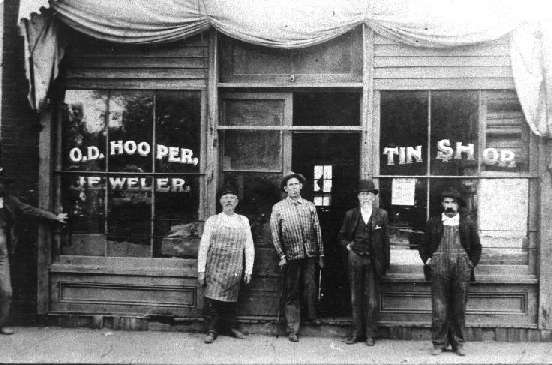
Cowden Grand Army of the Republic (GAR)
Samuel Akins Post 566 - about 1898
First Row, L. to R. -- William Valentine (seated), Marvin Dowell,
B. W. Jones, A. W. Spracklen, Virgil Bowman, Charles Wakefield,
David McElroy and William Anderson.
Second Row, L. to R. -- George B. Carlisle (standing),
Samuel Torrence, Jacob Wonus, James Perryman, Z. Moore (seated),
J. T. Horseman, John L. Perkins, Wm. Taylor, John Beck, T. D. Lamson
(standing), Milton Hunter, Albert Wakefield and C. D. Horseman.
Third Row, L. to R. -- Dr. C. H. Carr, J. Upperman, C. R. Hooper,
R. R. Jones, and C. C. Frye.
Fourth Row, L. to R. -- Rev. M. Bechtel, Thomas Lockart, J. H. Akins
and C. B. Harwood.
Fifth Row, L. to R. -- H. G. Conrad, Henry Robertson, J. C. Baird,
L. H. Williams, Charles E. Zeigler and Isaac Jones.

Charles R. Hooper
b. 10 Mar 1842
d. 19 Mar 1913
Buried in Mud Run Cemetery, Shelby County, IL.
Charles served in Co. C, 35th Illinois Inf, during the Civil
War, and was wounded in the battle of Missionary Ridge,
at Chattanooga, TN.

Otto Delavan "Bud" Hooper (1870-1951) owned a jewelry & tinsmith
shop in Cowden around the turn of the century. This picture is
thought to have been taken around 1900-1910. Bud is the one in the
picture with the crippled left leg, which was stunted at a young age
because of a puncture wound to his hip. The individual to the left of
Bud is thought to be Zeke Burrows based on the following paragraph from
Orren Jennings Hooper's autobiography. Orren (1904-1988) was Bud's son.
Others in the picture are unidentified.
"Bud" was the owner of the towns tinshop and jewelry repair shop. He was
an experienced tinsmith, as well as a watch and clock repairman. He had a
screened-in corner of the shop for his watch and clock repairs. He also
gave "Uncle" Zeke Burrows, a shoe cobbler, space in the shop for his
work. Once in payment for some work he had done - a matter of only a few
dollars - Bud received an old violin "fiddle" which, when supplied with
a new bridge and strings, was found to have a wonderful tone. An old
fiddler, Fred Stretch by name, cleaned up the instrument and, upon
examination found, on the inside, that the viola (instead of a violin) was
an Amati, or an imitation of that famous make. Later on tracing back the
various owners of the instrument, it was found that only two of these
imitation Amatis had come to this country. The trail of the instrument
led back to when it had been used in an orchestra in Cincinnati, Ohio,
before the Civil War. There the trail was lost. This Mr. Fred Stretch
used to borrow the instrument, to play in Old Fiddlers Contests, and it
was his brag that he never lost a contest when he used this particular
fiddle with it's wonderful tone.
Materials on this page
and linked webpages within this site are © 2002-2057 by Clay
Hooper, those that have submitted materials, and those that
have participated in the HOOPER DNA PROJECT. Family researchers and
tax-exempt genealogical societies may freely link to these web pages
and/or use the material personally, as described under copyright
law. All for-profit reproduction of these electronic pages - in any
format - by any other organization or persons is restricted by the
author. All others desiring to use this material must obtain written
consent of the copyright holder.